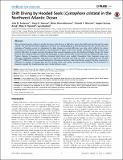Files in this item
Drift diving by hooded seals (Cystophora cristata) in the Northwest Atlantic Ocean
Item metadata
| dc.contributor.author | Andersen, Julie | |
| dc.contributor.author | Stenson, Garry | |
| dc.contributor.author | Skern-Maurizen, Mette | |
| dc.contributor.author | Wiersma , Yolanda | |
| dc.contributor.author | Rosing-Asvid, Aqqalu | |
| dc.contributor.author | Boehme, Lars | |
| dc.contributor.author | Hammill, Mike | |
| dc.date.accessioned | 2014-08-28T13:31:01Z | |
| dc.date.available | 2014-08-28T13:31:01Z | |
| dc.date.issued | 2014-07-22 | |
| dc.identifier | 136468389 | |
| dc.identifier | 3f13c47e-e68f-42c2-a7c1-07a0a6169276 | |
| dc.identifier | 84904659548 | |
| dc.identifier | 000339551100084 | |
| dc.identifier.citation | Andersen , J , Stenson , G , Skern-Maurizen , M , Wiersma , Y , Rosing-Asvid , A , Boehme , L & Hammill , M 2014 , ' Drift diving by hooded seals ( Cystophora cristata ) in the Northwest Atlantic Ocean ' , PLoS One , vol. 9 , no. 7 , e103072 . https://doi.org/10.1371/journal.pone.0103072 | en |
| dc.identifier.issn | 1932-6203 | |
| dc.identifier.uri | https://hdl.handle.net/10023/5278 | |
| dc.description | This work was funded through the Atlantic Seal Research Programme, International Governance Programme (GBS and MOH), the Greenland Institute of Natural Resources (ARA), and a CFI grant to YFW. The authors also acknowledge the support of the MASTS pooling initiative (The Marine Alliance for Science and Technology for Scotland) in the completion of this study. MASTS is funded by the Scottish Funding Council (grant reference HR09011) and contributing institutions (LB). | en |
| dc.description.abstract | Many pinniped species perform a specific dive type, referred to as a ‘drift dive’, where they drift passively through the water column. This dive type has been suggested to function as a resting/sleeping or food processing dive, and can be used as an indication of feeding success by calculating the daily change in vertical drift rates over time, which reflects the relative fluctuations in buoyancy of the animal as the proportion of lipids in the body change. Northwest Atlantic hooded seals perform drift dives at regular intervals throughout their annual migration across the Northwest Atlantic Ocean. We found that the daily change in drift rate varied with geographic location and the time of year and that this differed between sexes. Positive changes in buoyancy (reflecting increased lipid stores) were evident throughout their migration range and although overlapping somewhat, they were not statistically associated with high use areas as indicated by First Passage Time (FPT). Differences in the seasonal fluctuations of buoyancy between males and females suggest that they experience a difference in patterns of energy gain and loss during winter and spring, associated with breeding. The fluctuations in buoyancy around the moulting period were similar between sexes. | |
| dc.format.extent | 11 | |
| dc.format.extent | 1224046 | |
| dc.language.iso | eng | |
| dc.relation.ispartof | PLoS One | en |
| dc.subject | QH301 Biology | en |
| dc.subject.lcc | QH301 | en |
| dc.title | Drift diving by hooded seals (Cystophora cristata) in the Northwest Atlantic Ocean | en |
| dc.type | Journal article | en |
| dc.contributor.institution | University of St Andrews. School of Biology | en |
| dc.contributor.institution | University of St Andrews. Sea Mammal Research Unit | en |
| dc.contributor.institution | University of St Andrews. Marine Alliance for Science & Technology Scotland | en |
| dc.contributor.institution | University of St Andrews. Scottish Oceans Institute | en |
| dc.identifier.doi | https://doi.org/10.1371/journal.pone.0103072 | |
| dc.description.status | Peer reviewed | en |
| dc.identifier.url | http://www.plosone.org/article/info%3Adoi%2F10.1371%2Fjournal.pone.0103072#s5 | en |
| dc.identifier.url | http://www.plosone.org/article/info%3Adoi%2F10.1371%2Fjournal.pone.0103072 | en |
This item appears in the following Collection(s)
Items in the St Andrews Research Repository are protected by copyright, with all rights reserved, unless otherwise indicated.

